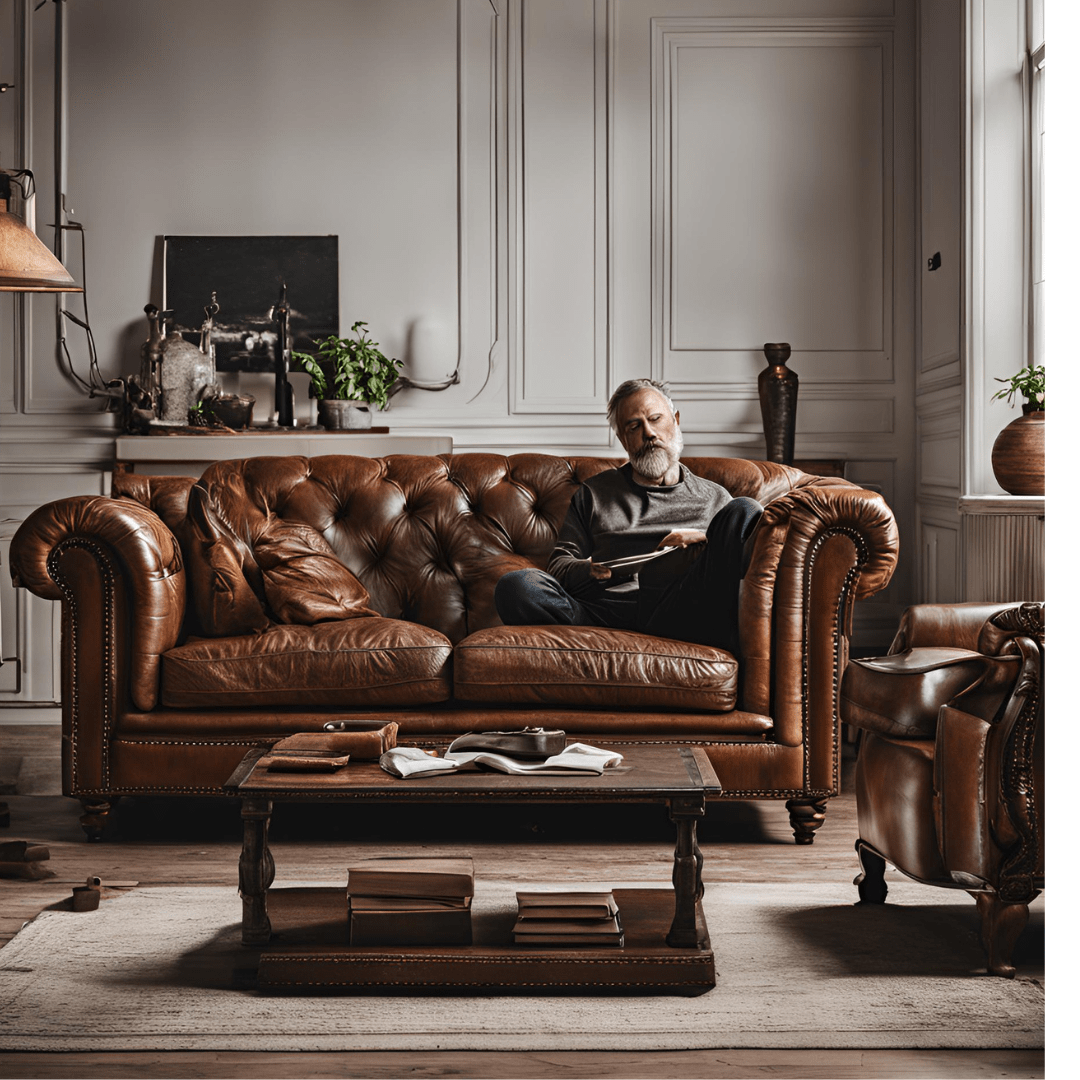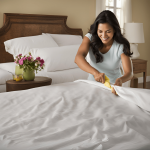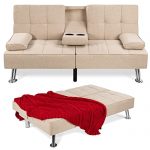
A leather couch should last between 10 to 15 years with proper care. High-quality leather can extend its lifespan even further.
Leather couches are a popular choice for their durability and timeless appeal. Quality leather furniture offers comfort and adds a touch of elegance to any living space. Regular maintenance, such as conditioning and cleaning, helps preserve the leather’s texture and appearance.
Investing in a leather couch means you are opting for a long-lasting piece of furniture. It’s important to understand the different grades of leather, as higher-quality options provide better longevity. By choosing the right leather and maintaining it well, you can enjoy your leather couch for many years.
Lifespan Factors
Leather couches are a timeless addition to any home. They offer both style and comfort. But how long should a leather couch last? Various factors impact the lifespan of a leather couch. These factors include material quality and usage patterns. Understanding these aspects you can help make an informed decision when buying or maintaining a leather couch.
Material Quality
The quality of the material significantly affects the longevity of a leather couch. High-quality leather often lasts longer. Here are some key points to consider:
- Full-grain leather: The highest quality leather. It is durable and can last over 20 years.
- Top-grain leather: Slightly lower in quality but still durable. It can last up to 15 years.
- Split-grain leather: Made from the lower layers of the hide. It is less durable and may last around 5-10 years.
- Bonded leather: Composed of leather scraps. It is the least durable and may last only 2-3 years.
The tanning process also plays a crucial role. Vegetable-tanned leather is more durable than chrome-tanned leather. Stitching quality is another factor. Well-stitched seams add to the couch’s durability.
Usage Patterns
How you use your leather couch affects its lifespan. Here are some important points to note:
- Frequency of use: A frequently used couch wears out faster. For example, a living room couch used daily might last 10-15 years. In contrast, a guest room couch used occasionally could last over 20 years.
- Care and maintenance: Regular cleaning and conditioning extend the couch’s life. Wipe spills immediately and use leather conditioners every 6 months.
- Exposure to sunlight: Direct sunlight can fade and dry out leather. Placing your couch away from windows can help.
- Pets and children: Pets and children may cause more wear and tear. Pet claws can scratch the leather, and spills from children can stain it.
Using protective covers and teaching kids and pets to treat the couch gently can also extend its life.
Types Of Leather
Leather couches are an investment that can last for many years. The longevity of a leather couch depends on the type of leather used. Different types of leather offer varying levels of durability, comfort, and maintenance. Understanding these types can help you choose a couch that fits your lifestyle and lasts longer.
Full Grain
Full grain leather is the highest quality leather available. It is made from the top layer of the hide, which includes all of the natural grain. This type of leather is known for its durability and unique appearance.
Here are some key features of full grain leather:
- Durability: Full grain leather is incredibly strong and resistant to wear and tear. It can last for decades with proper care.
- Appearance: It retains the natural texture of the hide, showing scars and imperfections that add to its character.
- Patina: Over time, full grain leather develops a rich patina, enhancing its beauty and uniqueness.
Full grain leather requires regular maintenance to keep it looking its best. Here are some tips:
- Clean spills immediately with a dry cloth.
- Use a leather conditioner every 6-12 months to keep the leather supple.
- Avoid placing the couch in direct sunlight to prevent fading.
| Feature | Full Grain Leather |
|---|---|
| Durability | High |
| Appearance | Natural grain, unique scars |
| Maintenance | Regular conditioning needed |
Bonded Leather
Bonded leather is made from leftover leather scraps that are bonded together with polyurethane or latex. This type of leather is more affordable but less durable than full grain leather.
Here are some characteristics of bonded leather:
- Cost: Bonded leather is cheaper, making it a budget-friendly option.
- Appearance: It has a uniform look and can mimic the appearance of higher-quality leather.
- Durability: It is less durable and can wear out faster, especially in high-use areas.
Bonded leather requires less maintenance but has a shorter lifespan. Here are some tips to extend its life:
- Clean regularly with a damp cloth to remove dust and dirt.
- Use a leather conditioner to prevent cracking.
- Avoid harsh chemicals that can damage the surface.
| Feature | Bonded Leather |
|---|---|
| Cost | Low |
| Appearance | Uniform, mimics higher-quality leather |
| Durability | Low |
Care Techniques
Leather couches are an elegant addition to any living space, and with proper care, they can last for many years. The key to prolonging the life of a leather couch lies in regular maintenance and appropriate care techniques.
These practices ensure that the leather remains supple and free from damage. In this blog post, we will delve into some essential care techniques to help your leather couch stand the test of time.
Regular Cleaning
Regular cleaning is crucial to maintain the beauty and durability of your leather couch. Dust, dirt, and body oils can accumulate on the leather surface, causing it to deteriorate over time. Follow these simple steps for effective cleaning:
- Dust Weekly: Use a soft, dry cloth to remove dust from the couch every week. This prevents dirt from embedding into the leather.
- Vacuum Monthly: Use a vacuum cleaner with a soft brush attachment to clean crevices and seams. This helps remove deeper dirt and debris.
- Wipe Spills Immediately: Blot any spills with a clean cloth as soon as they occur to prevent staining.
For deep cleaning, use a leather cleaner specifically designed for your type of leather. Here’s a quick guide:
| Leather Type | Cleaning Method |
|---|---|
| Full-Grain Leather | Use a mild soap and water solution. Wipe gently with a damp cloth. |
| Top-Grain Leather | Apply a leather cleaner with a soft cloth. Follow the product instructions. |
| Bonded Leather | Avoid harsh chemicals. Use a damp cloth with a small amount of mild soap. |
Conditioning Products
Conditioning your leather couch is essential to keep the leather soft and to prevent cracks. Leather conditioners replenish the natural oils in the leather, maintaining its flexibility and appearance.
Here are some key tips for conditioning:
- Choose the Right Conditioner: Ensure the product matches the type of leather. Not all conditioners are suitable for every type of leather.
- Test on a Small Area: Before applying the conditioner to the entire couch, test it on a hidden area. This ensures the product does not cause discoloration.
- Apply Sparingly: Use a soft cloth to apply a small amount of conditioner. Rub it gently into the leather in circular motions.
- Allow to Absorb: Let the conditioner sit for a few hours or overnight. This allows the leather to absorb the oils fully.
- Buff the Surface: After the conditioner is absorbed, use a clean, dry cloth to buff the leather. This gives it a nice shine and removes any excess product.
Condition the leather couch every 6 to 12 months, depending on the environment and usage. Regular conditioning can significantly extend the life of your leather couch, keeping it looking as good as new.
Signs Of Wear
Your leather couch is an investment that should last for many years. But how long should a leather couch really last? The answer depends on various factors, such as the quality of leather, care, and usage. To determine if your couch is nearing the end of its life, look for common signs of wear. Below, we discuss two major indicators: cracks and fading, and stains and odors.
Cracks And Fading
One of the first signs your leather couch is aging is the appearance of cracks and fading. High-quality leather can withstand years of use, but over time, it will show signs of wear. Cracks and fading are often due to exposure to sunlight, heat, and lack of proper conditioning.
Keep an eye out for:
- Visible Cracks: Small lines or breaks in the leather surface.
- Color Fading: The leather loses its rich, original color, especially in areas exposed to sunlight.
To help you understand the stages of leather wear, here’s a simple table:
| Stage | Signs |
|---|---|
| Early | Minor cracks, slight fading |
| Mid | Noticeable cracks, significant color loss |
| Late | Deep cracks, severe fading |
Regular conditioning and keeping your couch out of direct sunlight can help prolong its life. If you notice deep cracks or severe fading, it might be time for your repairs or replacement.
Stains And Odors
Another sign of wear on your leather couch is the presence of stains and odors. Leather is porous, meaning it can absorb spills and smells over time. These can make your couch look and smell old.
Watch out for:
- Stains: Spills from food, drinks, or other substances leaving marks.
- Odors: Persistent smells from pets, smoke, or mildew.
Here’s a quick checklist to manage stains and odors:
- Clean spills immediately to prevent absorption.
- Use a leather cleaner for regular maintenance.
- Air out your couch periodically to remove trapped odors.
For tough stains or persistent odors, consider professional cleaning. Regular maintenance can help keep your leather couch looking and smelling fresh for longer.
Repair Options
Leather couches are a popular choice due to their durability and timeless appeal. But like all furniture, they can show signs of wear over time. Knowing your repair options can help extend the life of your leather couch. Whether you opt for DIY repairs or professional services, each option has its benefits and drawbacks. Let’s explore both in detail.
Diy Repairs
DIY repairs can be a cost-effective way to maintain your leather couch. Basic repairs like fixing scratches or small tears can be done with minimal tools. Here are some common DIY repair methods:
- Leather Repair Kits: These kits usually contain everything you need to fix minor damages. Look for kits that include a variety of color options to match your couch.
- Conditioners and Cleaners: Regular use of leather conditioners and cleaners can help maintain the leather’s suppleness and prevent cracks.
- Patch Kits: Patch kits can be effective for larger tears. These kits often include adhesive patches that blend seamlessly with the leather.
Here is a simple table to guide you on the tools you might need:
| Repair Type | Tools Needed |
|---|---|
| Scratches | Leather conditioner, soft cloth |
| Small Tears | Leather repair kit |
| Large Tears | Patch kit, adhesive |
DIY repairs can save you money and give you a sense of accomplishment. But they require time and attention to detail. Always test a small, hidden area first to ensure the products won’t damage the leather.
Professional Services
For more extensive damage, professional services might be the best option. Professionals have the expertise and tools to handle complex repairs. Here are some benefits of choosing professional services:
- Expertise: Professionals have years of experience in handling various types of leather and damage.
- Quality of Work: They use high-quality materials and techniques, ensuring the repair is durable and blends well with the original leather.
- Time-Saving: Professional repairs can be quicker, allowing you to enjoy your couch sooner.
Here’s a table comparing DIY repairs and professional services:
| Aspect | DIY Repairs | Professional Services |
|---|---|---|
| Cost | Low | High |
| Time | Variable | Quick |
| Quality | Good (if done correctly) | Excellent |
| Convenience | Requires personal effort | Hassle-free |
Professional services can be more expensive, but they offer a level of expertise and quality that DIY methods may not match. When your couch has been significantly damaged, investing in professional repairs can be a wise choice.
Environmental Impact
Leather couches are known for their durability and elegance. But how long should a leather couch last? The environmental impact plays a crucial role in the lifespan of your leather furniture. Factors such as climate and location can significantly affect the longevity of your couch.
Climate Factors
Climate can greatly influence the durability of your leather couch. Different climates cause the leather to age differently.
- Humid climates can cause leather to absorb excess moisture. This can lead to mold and mildew growth.
- Dry climates can cause leather to dry out and crack. Proper conditioning is essential in these areas.
- Extreme temperatures can cause significant wear and tear on leather. Both hot and cold temperatures can cause the leather to become brittle.
A table can help illustrate the effects of different climates on leather:
| Climate Type | Impact on Leather |
|---|---|
| Humid | Mold, Mildew |
| Dry | Cracking |
| Extreme Temperatures | Brittleness |
Understanding climate factors is essential for proper leather couch maintenance. Using humidifiers or dehumidifiers can help control the indoor climate and extend the life of your couch.
Location Considerations
The location of your leather couch within your home also impacts its lifespan. Various factors need to be considered.
- Sunlight exposure can cause the leather to fade and become brittle. Placing your couch away from direct sunlight can prevent this.
- Proximity to heat sources such as radiators or fireplaces can dry out the leather. It is advisable to keep your couch at a safe distance.
- High-traffic areas can lead to quicker wear and tear. Leather couches in these areas may need more frequent maintenance.
A table summarizing location considerations:
| Location Factor | Impact on Leather |
|---|---|
| Sunlight Exposure | Fading, Brittle |
| Proximity to Heat Sources | Drying, Cracking |
| High-Traffic Areas | Wear and Tear |
Placing your leather couch thoughtfully within your home can significantly extend its lifespan. Consider factors like sunlight, heat sources, and traffic to ensure your leather couch remains in top condition for years to come.
Warranty Insights
Buying a leather couch is a significant investment. Knowing how long it should last is crucial. One key factor is the warranty that comes with it. A solid warranty can indicate the expected longevity of your couch. Let’s dive into the details with some warranty insights.
Manufacturer Guarantees
Manufacturer guarantees often provide a good indication of the quality and durability of a leather couch. These guarantees vary from one manufacturer to another. Typically, they cover:
- Frame: Often, the frame is covered for up to 10 years. Quality frames are made from hardwoods and should last as long as the warranty.
- Cushions: Cushion warranties usually range between 1 to 5 years. High-resilience foam cushions may have longer warranties.
- Leather: Leather warranties can vary significantly. Top-grain leather might come with a 5 to 10-year warranty, while bonded leather might only have a 1-year warranty.
Understanding these guarantees helps in assessing the expected lifespan of your couch. Below is a table summarizing common warranty periods:
| Component | Warranty Period |
|---|---|
| Frame | 5-10 years |
| Cushions | 1-5 years |
| Leather | 1-10 years |
Extended Warranties
Extended warranties offer additional protection beyond the standard manufacturer guarantees. These warranties can be purchased separately and often cover:
- Accidental damage: Such as spills, tears, and stains.
- Wear and tear: Extended warranties often include coverage for normal wear and tear, which is not typically covered by manufacturer guarantees.
- Extended periods: These warranties can extend coverage for up to 5 more years.
Investing in an extended warranty can provide peace of mind. It ensures coverage for issues that might arise after the manufacturer’s warranty expires. Here’s a breakdown of typical extended warranty features:
| Feature | Extended Period |
|---|---|
| Accidental Damage | Up to 5 years |
| Wear and Tear | Up to 5 years |
| Frame and Cushions | Additional 5 years |
Choosing an extended warranty can be a wise decision. It safeguards your investment and ensures your leather couch remains in top condition for many years.
Investment Value
A leather couch is more than just a piece of furniture; it’s an investment. Understanding the investment value of a leather couch involves considering its longevity and potential resale value. This helps you make an informed decision about spending your hard-earned money.
Cost Vs. Longevity
The cost of a leather couch can be high. However, its long lifespan makes it a worthwhile investment. Leather couches can last up to 15-20 years with proper care. This is much longer than fabric couches, which may only last 5-10 years.
Here are some factors affecting the longevity of a leather couch:
- Quality of leather: Top-grain leather lasts longer than bonded leather.
- Maintenance: Regular cleaning and conditioning extend the life of the leather.
- Usage: Heavy usage can wear out a couch faster.
Investing in a high-quality leather couch can save you money in the long run. Here’s a simple comparison:
| Type of Couch | Average Lifespan | Initial Cost |
|---|---|---|
| Leather Couch | 15-20 years | $1,500 – $5,000 |
| Fabric Couch | 5-10 years | $500 – $1,500 |
This table shows that while leather couches are more expensive, their long lifespan makes them a better investment.
Resale Potential
A leather couch not only lasts longer but also holds its value better. The resale potential is an important factor to consider. A well-maintained leather couch can fetch a good price in the second-hand market.
Factors affecting resale value include:
- Condition: A couch in good condition sells for a higher price.
- Brand: Well-known brands have higher resale value.
- Style: Timeless designs are more appealing to buyers.
Resale values for different conditions:
| Condition | Resale Value |
|---|---|
| Excellent | 60-70% of original price |
| Good | 40-50% of original price |
| Fair | 20-30% of original price |
This table highlights the resale potential of a leather couch. Even after many years, a well-maintained leather couch can bring back a significant portion of the initial investment. Investing in a leather couch is not just about comfort, but also about long-term value.
Frequently Asked Questions
How Long Does A Leather Couch Typically Last?
A high-quality leather couch can last 15-20 years with proper care. Regular maintenance and avoiding direct sunlight can extend its lifespan.
What Factors Affect A Leather Couch’s Durability?
Leather type, usage, and care determine a couch’s durability. Full-grain leather is the most durable. Proper maintenance is crucial.
How Can I Extend My Leather Couch’s Life?
Regularly clean and condition your leather couch. Keep it away from direct sunlight and heat sources to prevent damage.
Is A Leather Couch Worth The Investment?
Yes, leather couches are durable and can last decades. They also add a touch of luxury to any room.
Conclusion
A leather couch can last many years with proper care. Regular cleaning and conditioning are essential. Choose high-quality leather for better durability. Avoid direct sunlight and spills to maintain its appearance. Investing in a leather couch is worthwhile for its longevity and timeless appeal.
Enjoy your leather couch for decades.








